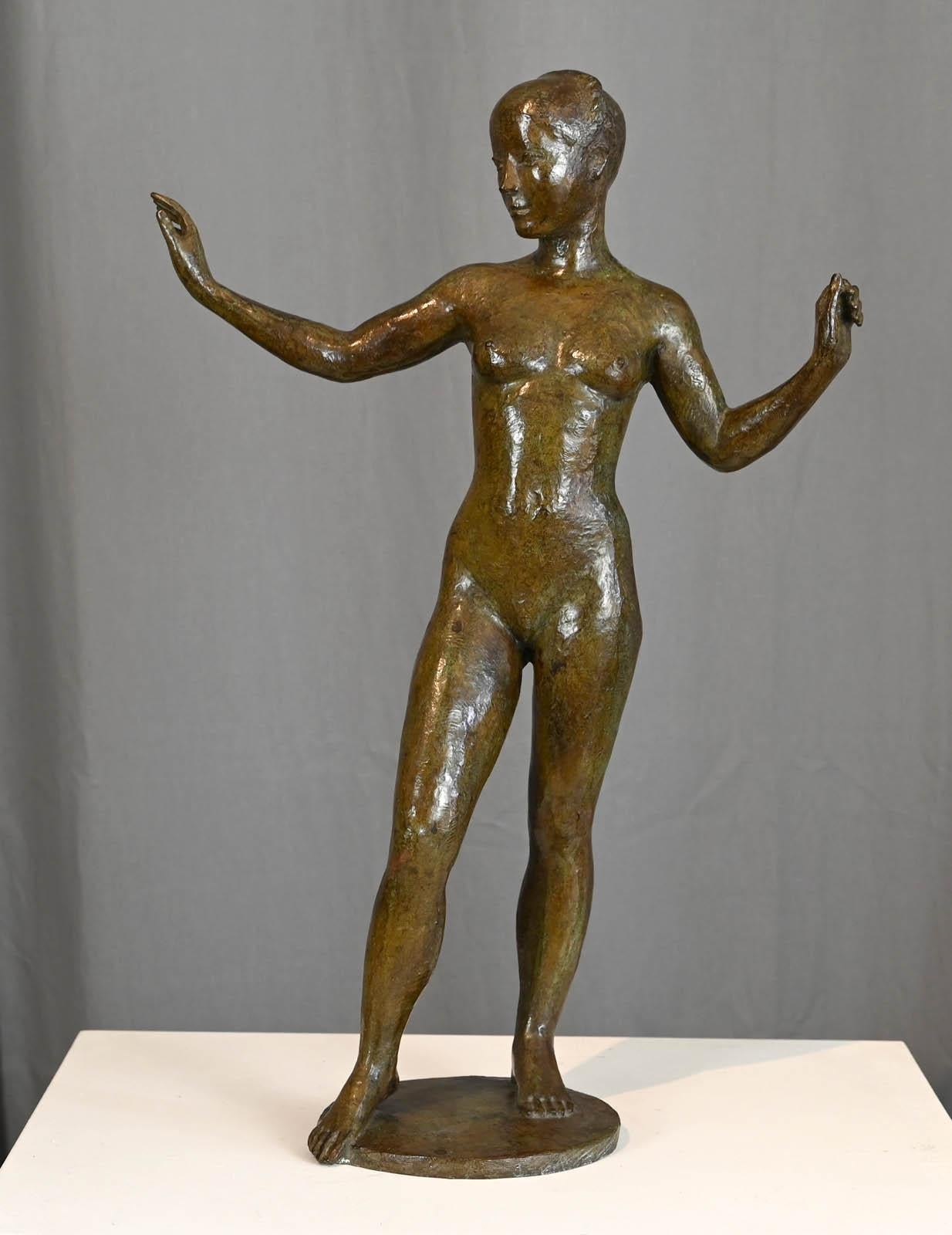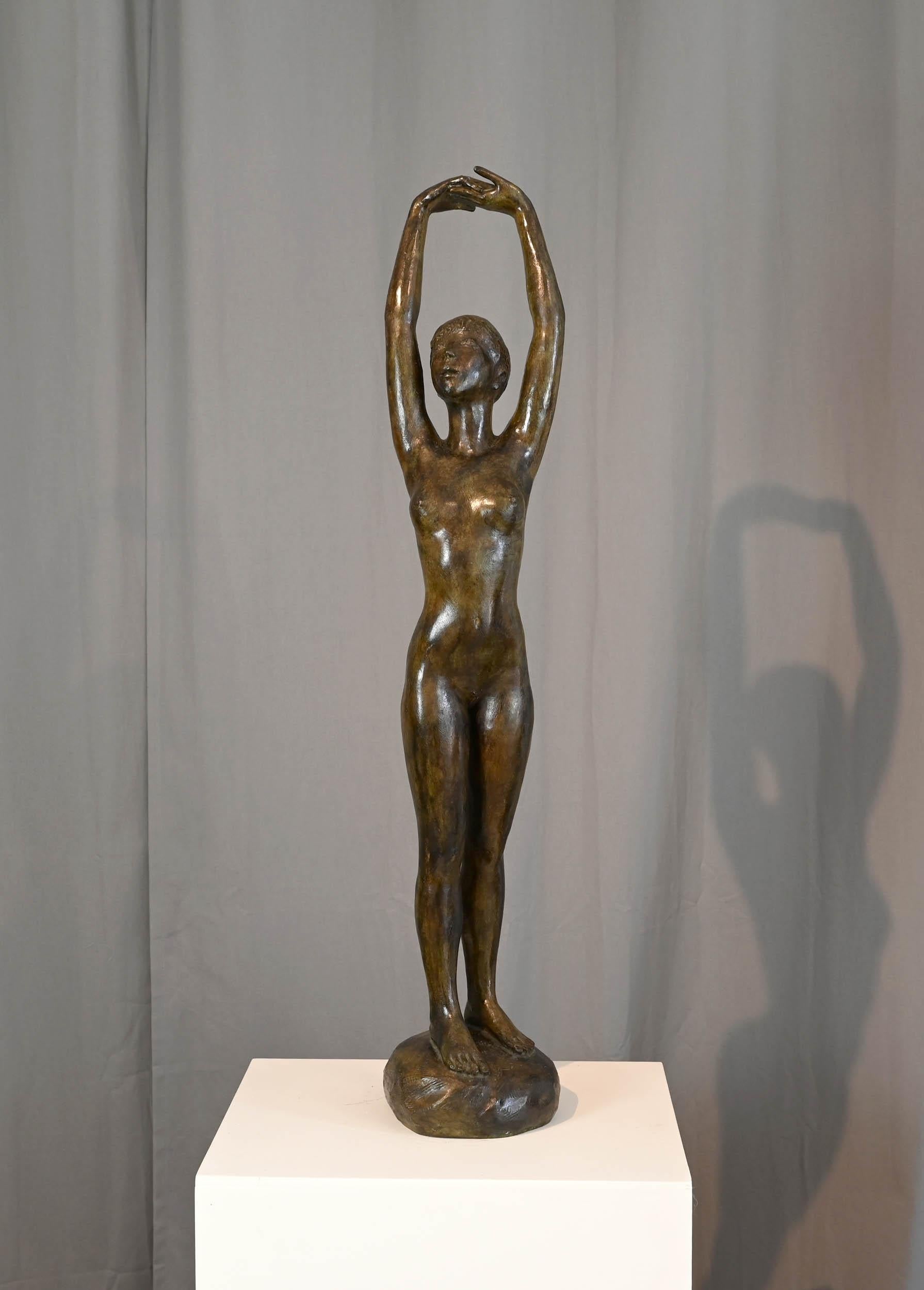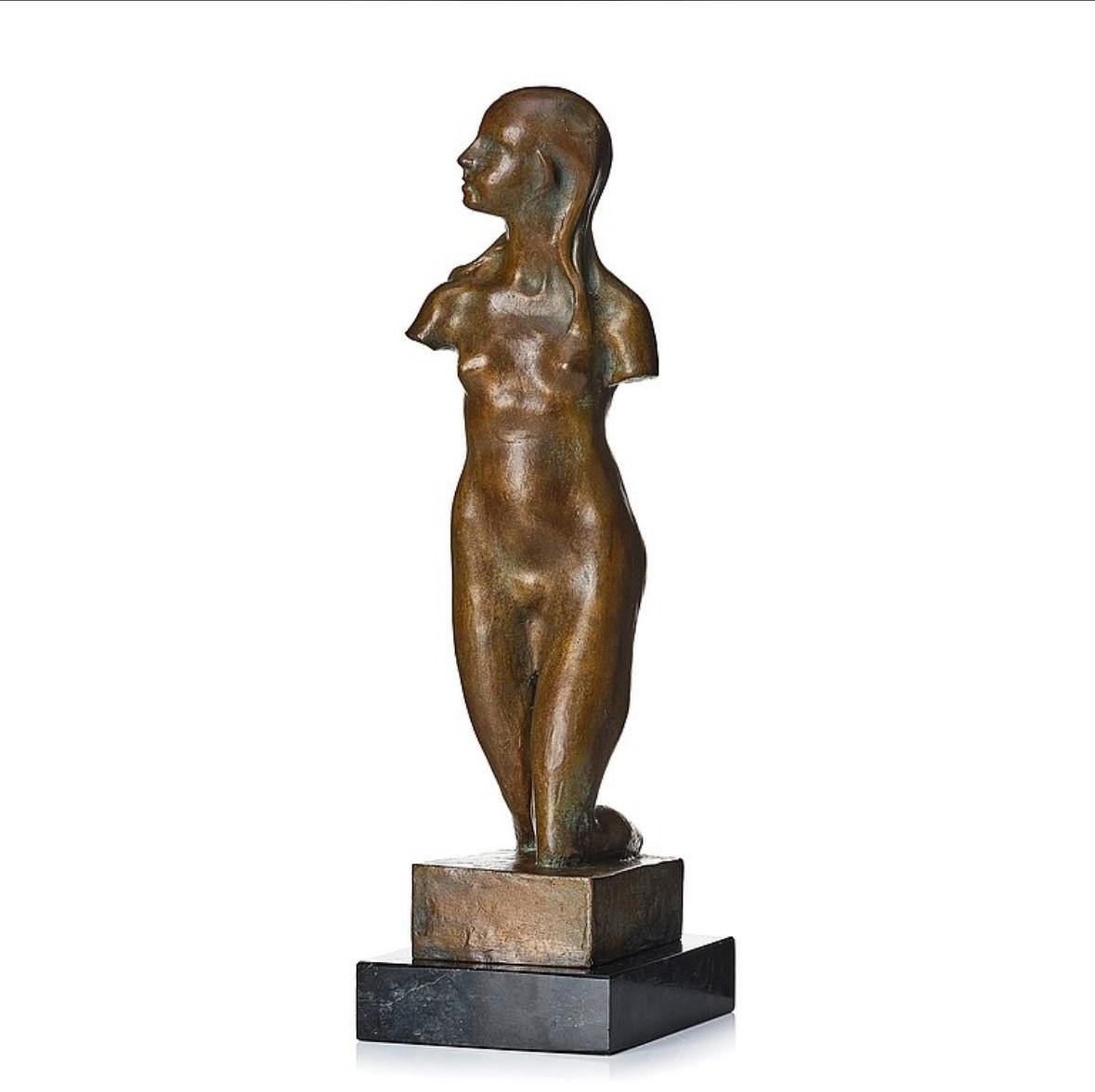Want more images or videos?
Request additional images or videos from the seller
1 of 8
Etienne HachenburgerBathercirca 1908
circa 1908
About the Item
Bather
by Etienne Hachenburger (19th-20th C.)
Sculpture in white Carrara marble
Signed on the side of the base "E. Hachenburger"
A simiilar model was exhibited at the Paris Salon oh 1908
France
around 1908
height 62 cm ; width 36 cm ; depth 35 cm
Biography :
Etienne Hachenburger (19-20th century) was a French sculptor born in Paris. He was a student at the Julian Academy, an academy which prepared students to enter the School of Fine Arts, to compete for the Prix de Rome or to present their works at the Salons. He learned sculpture under the direction of Raoul Verlet (1857-1923) and Jacques Perrin (1847-1915).
Etienne Hachenburger exhibited under number 3182, at the 1906 Salon of the French Artists, a "Bather", the first version of our marble sculpture. It was a plaster which then won the honors of the critics, who relayed the event in "L'Art et le Beau" (monthly magazine, n°7, July 1906, pp.143-144). Building on its success, Hachenburger exhibited the marble version at the Salon of 1908, under number 3229.
Etienne Hachenburger was a member of the French Artists society since 1907, and obtained an honorable mention in 1910 with his statue "At the edge of the source".
- Creator:Etienne Hachenburger (French)
- Creation Year:circa 1908
- Dimensions:Height: 24.41 in (62 cm)Width: 14.18 in (36 cm)Depth: 13.78 in (35 cm)
- Medium:
- Movement & Style:
- Period:
- Condition:
- Gallery Location:PARIS, FR
- Reference Number:

About the Seller
5.0
Vetted Seller
These experienced sellers undergo a comprehensive evaluation by our team of in-house experts.
Established in 1992
1stDibs seller since 2023
Typical response time: 20 hours
- ShippingRetrieving quote...Ships From: PARIS, France
- Return PolicyA return for this item may be initiated within 3 days of delivery.
More From This SellerView All
- Snake CharmerBy Albert-Ernest Carrier-BelleuseLocated in PARIS, FRBronze sculpture with a nuanced dark brown patina signed on the base "A. Carrier" inscribed on a front plaque "Charmeuse de Serpents par Carrier-Belleuse" France circa 1860 height 80,5 cm Biography : Albert-Ernest Carrier de Belleuse known as Carrier-Belleuse (1824-1887) was one of the most prolific artists of the century and had the greatest successes under the Second Empire, enjoying the personal support of Napoleon III. His work was greatly influenced by the style of the Italian Renaissance and that of the 18th century, which he helped to bring up to date. In 1837, the young Carrier-Belleuse apprenticed in the workshop of the engraver Bauchery. He was admitted soon after to the goldsmith Jacques Henri Fauconnier. Through François Arago, he met the sculptor David d'Angers who facilitated his admission to the School of Fine Arts. Carrier-Belleuse entered it in 1840. Noted for his skill by the great bronze companies in Paris such as Barbedienne and Denière, he soon received numerous orders for models for candelabras, pendulums, fittings for fireplaces, etc. In 1848, probably at the initiative of François Arago, who became head of state, he received his first public order for a small statue of "Mademoiselle Rachel singing La Marseillaise". In 1851, he appeared for the first time at the Salon of French Artists, where he presented two bronze medallions. From 1851 to 1855, Carrier-Belleuse stayed in England, in Stoke-on-Trent where he served as director of the modeling and drawing school of the Minton house, a large porcelain manufacturer. Back in France, Carrier-Belleuse moved to Paris in a large workshop located 15 rue de la Tour d´Auvergne. From 1857, he made regular sendings to the Salon and became famous thanks to the success of large marbles, such as the "Bacchante" exhibited at the Salon in 1863, and acquired by Napoleon III, "Angelica" (1866) or even "Hebe asleep" (1869). At the Salon of 1867, his group entitled "Messiah" earned him the medal of honor of sculpture. It was acquired by the State to adorn the Chapel of the Virgin in the Saint-Vincent-de-Paul church. Carrier-Belleuse acquired a great reputation in parallel for his terracotta busts which, in many respects, recall those of 18th century artists. He made portraits of a large number of celebrities of his time. He produced, among others, the busts of Napoleon III, Renan, Thiers, Grévy, Arago, Marguerite Bellanger, Théophile Gautier, Honoré Daumier, Delacroix, Hortense Schneider, Réjane… He also modelled numerous busts of mythological inspiration and historical and artistic portraits like Marie Stuart, Shakespeare or even Mozart. Carrier-Belleuse used and trained in his workshop in the rue de la Tour d´Auvergne many young talented artists such as Alexandre Falguière, Jules Desbois...Category
1860s French School Figurative Sculptures
MaterialsBronze
- Woman taking off her shirtLocated in PARIS, FRWoman taking off her shirt by James PRADIER (1790-1852) Bronze with a nuanced brown patina cast by SOYER and INGE France circa 1850 height 28,5 cm Biography : Jean-Jacques Pradier...Category
1850s French School Nude Sculptures
MaterialsBronze
- The ComedyLocated in PARIS, FRPierre-Marie POISSON (1876-1953) The Comedy Bronze sculpture with black patina signed on the base "P. Poisson" Cast by Valsuani (with the foundry stamp) Raised on a stone base Fra...Category
1930s French School Figurative Sculptures
MaterialsBronze
- The KissBy Aimé-Jules DalouLocated in PARIS, FRThe Kiss also named "Nymph and Faun" by Jules DALOU (1838-1902) A bronze group with a black patina Signé "Dalou" A very fine cast by "A.A. Hébrard" (with the foundry stamp) The ca...Category
Early 1900s French School Figurative Sculptures
MaterialsBronze
- Torso of a WomanLocated in PARIS, FRTorso of a Woman by Marcel GIMOND (1894-1961) Avery fine nuanced brown chamotte sandstone sculpture raised on a dark grey marble base signed on the arm with the monogram "MG" for Marcel Gimond inscribed with the monogram "GS" for Georges Serré stamped by the galerie Rouard France 1927 total height 50 cm width 20,5 cm depth 20 cm After a model by Marcel Gimond, this bust was made in 1927 by Georges Serré at the Manufacture de Sèvres, sold exclusively by the Rouard Gallery, and exhibited the same year at the Paris Fall Fair (Salon d'Automne). Reproduced in "Sculpteurs nouveaux, Marcel Gimond", Paul Fierens, Nrf, 1930, cover. Biographies : Marcel Gimond (1894-1961) was a French sculptor. He studied in Lyon, then at the School of Fine Arts in Lyon where he graduated in 1917. Finally he arrived in Paris the same year and settled in Marly-Le-Roi. Student of Aristide Maillol, he also met Raoul Dufy and Auguste Renoir. Gimond worked with Maillol until 1920, and left him to settle in Paris and regain his independence. He then moved into Renoir's former studio, made available by Jean Renoir. He exhibited at the Salon des Indépendants and the Salon d'Automne in 1922. In 1940, Gimond left Paris to settle in the South zone, in Lyon, then in Aix en Provence; He spent his summers at Saint-Félicien, at the house of poet Charles Forot. At the Liberation, in 1944, he returned to Paris and his workshop rue Ordener, he left only a few months before his death. From 1946 to 1960, he directed a workshop at the Ecole des Beaux-Arts in Paris. Marcel Gimond was known for his busts of political and artistic personalities. He also owed two bas-reliefs located in the lobby of the newspaper "L'Humanité", in tribute to Marcel Cachin and Gabriel Péri. Georges Serré (1889-1956) was a French ceramist. He worked at the Sèvres factory until 1914, when he was mobilized to go to war. He then went to Indochina where he taught ceramics at the art school of Bien-hoa for five years. On his return to France, he moved to Sèvres, rue Brongniart, but encountered difficulties in producing his works, until the intervention of the ceramist Emile Decoeur who obtained him help to build an oven for firing his ceramics. It was Georges Rouard and his gallery located on avenue de l'Opéra in Paris, who had noticed him at the International Exhibition of Modern Decorative and Industrial Arts of 1925, which presented him during his "exhibitions of contemporary French artisans". Georges Serré's taste for these sandstones came to him, among other things, from Khmer sculptures...Category
1920s French School Figurative Sculptures
MaterialsTerracotta
- Diana with an arrowBy Albert-Ernest Carrier-BelleuseLocated in PARIS, FRDiana with an arrow by Albert-Ernest CARRIER-BELLEUSE (1824-1887) Bronze sculpture with a dual light and dark brown patina signed on the base "Carrier-Belleuse" inscribed on a front plaque "Diane à la Flèche par Carrier-Belleuse (Sculptr)" France circa 1870 height 83 cm arrow added probably in the 20th c. Biography : Albert-Ernest Carrier de Belleuse known as Carrier-Belleuse (1824-1887) was one of the most prolific artists of the century and had the greatest successes under the Second Empire, enjoying the personal support of Napoleon III. His work was greatly influenced by the style of the Italian Renaissance and that of the 18th century, which he helped to bring up to date. In 1837, the young Carrier-Belleuse apprenticed in the workshop of the engraver Bauchery. He was admitted soon after to the goldsmith Jacques Henri Fauconnier. Through François Arago, he met the sculptor David d'Angers who facilitated his admission to the School of Fine Arts. Carrier-Belleuse entered it in 1840. Noted for his skill by the great bronze companies in Paris such as Barbedienne and Denière, he soon received numerous orders for models for candelabras, pendulums, fittings for fireplaces, etc. In 1848, probably at the initiative of François Arago, who became head of state, he received his first public order for a small statue of "Mademoiselle Rachel singing La Marseillaise". In 1851, he appeared for the first time at the Salon of French Artists, where he presented two bronze medallions. From 1851 to 1855, Carrier-Belleuse stayed in England, in Stoke-on-Trent where he served as director of the modeling and drawing school of the Minton house, a large porcelain manufacturer. Back in France, Carrier-Belleuse moved to Paris in a large workshop located 15 rue de la Tour d´Auvergne. From 1857, he made regular sendings to the Salon and became famous thanks to the success of large marbles, such as the "Bacchante" exhibited at the Salon in 1863, and acquired by Napoleon III, "Angelica" (1866) or even "Hebe asleep" (1869). At the Salon of 1867, his group entitled "Messiah" earned him the medal of honor of sculpture. It was acquired by the State to adorn the Chapel of the Virgin in the Saint-Vincent-de-Paul church. Carrier-Belleuse acquired a great reputation in parallel for his terracotta busts which, in many respects, recall those of 18th century artists. He made portraits of a large number of celebrities of his time. He produced, among others, the busts of Napoleon III, Renan, Thiers, Grévy, Arago, Marguerite Bellanger, Théophile Gautier, Honoré Daumier, Delacroix, Hortense Schneider, Réjane… He also modelled numerous busts of mythological inspiration and historical and artistic portraits like Marie Stuart, Shakespeare or even Mozart. Carrier-Belleuse used and trained in his workshop in the rue de la Tour d´Auvergne many young talented artists such as Alexandre Falguière, Jules Desbois...Category
1870s French School Nude Sculptures
MaterialsBronze
You May Also Like
- MarieLocated in LE HAVRE, FRJacques COQUILLAY (né en 1935) Marie Original bronze Size : 56x39x17cm Copy No. 4/8 Signature and numbered on the base. Original bronze made with ...Category
Early 2000s French School Nude Sculptures
MaterialsBronze
- VictoireLocated in LE HAVRE, FRJacques COQUILLAY (né en 1935) Victoire Original bronze Size : 105 x 22 x 20 cm Copy No. 1/8 Signature and numbered on the base. Original bronze m...Category
Early 2000s French School Nude Sculptures
MaterialsBronze
- Female torsoLocated in Täby, SEGunnar Knut Nilsson, born 1904 in Karlskrona, died 1995 in Versailles in France, was a Swedish sculptor. Gunnar Nilsson studied watercolor painting and modeling at the Technical Vocational School in Karlskrona in 1918-19 and on his own in addition to working as a clerk at Finspångs Metallwerk. His debut exhibition was in Finspång in 1927. With the help of a local fundraiser, and after the encouragement of Carl Eldh, he traveled to Paris in 1928 to study sculpture for, among others, Charles Despiau and Paul Niclausse. In Paris he socialized with Bror Hjorth, whose former studio he also rented, Carl Frisendahl and Alberto Giacometti. He came to belong to "Le groupe des Neuf'' with Paul Cornet...Category
1950s French School Nude Sculptures
MaterialsBronze
- Monumental Italian Rationalist Marble Sculptures of Hercules and DiscoboloLocated in Rome, ITThis monumental pair of sculptures in "Bardiglio" marble represent Greek Athlete of Discobolo and the Hercules figure with a lion pelt, on a cylindrical base . Exaltation of the male...Category
1960s Modern Figurative Sculptures
MaterialsMarble
- Medusa - statuesque hand carved Carrara marble and Italian linden wood sculptureBy Lorenzo VignoliLocated in San Francisco, CAstriking hand carved Carrara marble and linden wood sculpture by contemporary Italian sculptor Lorenzo Vignoli, incorporating classical references and Greek mythology influences Med...Category
21st Century and Contemporary Contemporary Figurative Sculptures
MaterialsStone, Marble
- Gallulus Bronze Sculpture Nude Boy Male Figure Green Patina Marble StoneBy Wim van der KantLocated in Utrecht, NLGallulus Bronze Sculpture Nude Boy Male Figure Green Patina Marble Stone Wim van der Kant (1949, Kampen) is a selftaught artist. Next to his busy profess...Category
21st Century and Contemporary Contemporary Nude Sculptures
MaterialsMarble, Bronze
Recently Viewed
View AllMore Ways To Browse
Marble Sculpture Nude
Circa 1857
Antique Marble Nude
Statues Rome Antique
Nudes In Plaster
Antique Plaster Statues
French Plaster Statues
Nude Marble Statue
Nude Plaster Sculpture
Bather Sculpture
Le Beau
Antique Monthly Magazine
Jacques Perrin
Hidden Pencil
Horse Japan
Horse Japanese
Italian Baroque Canvas
Lady With Child


